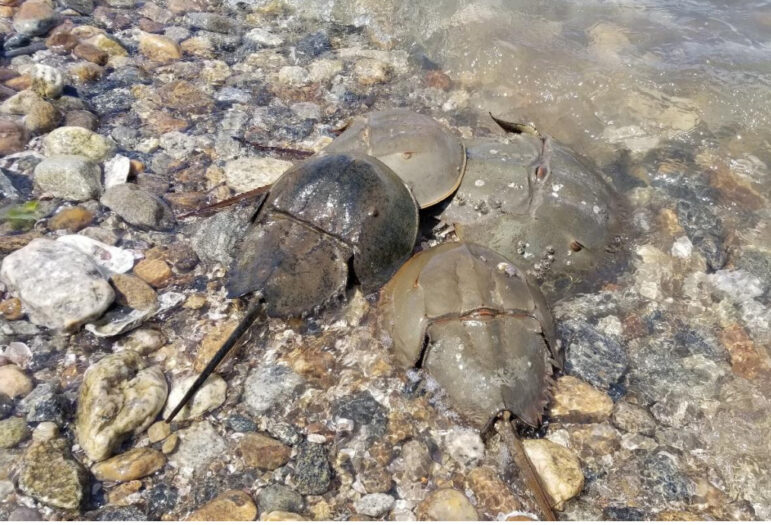Written and edited by Sarah Coccaro and Rebecca Poirier, June 2023.
It’s that time of year again! Horseshoe crabs can once again be seen on Greenwich beaches from mid-
May through to at least the beginning of July. There are four different species of Horseshoe crabs. The ones we see here in Greenwich are Limulus polyphemus (Linnaeus). Horseshoe crabs are living fossils;
they have existed for over 445 million years (longer than dinosaurs) with little to no adaptations.
Every spring, during both the new and full moon around the high tide, female horseshoe crabs haul themselves up to the wrack line (the high tide line) to lay hundreds of tiny blue/green eggs. As they trek to the high tide line, females will sometimes have multiple male horseshoe crabs attached in a chain to her.

During the spawning season, Town of Greenwich Conservation Commission staff, Commission members and volunteers, participate in “Project Limulus,” a Sacred Heart University citizen science monitoring and tagging program. Started in 1998, Project Limulus has conducted multiple studies focusing on the life history of the American horseshoe crab population living within Long Island Sound (LIS). Each year, beach groups conduct counting, tagging, and recapture analysis of adult horseshoe crabs.
If you do get lucky enough to see a horseshoe crab on the beach, you might wonder if it is dangerous because of its spike-like tail (called a telson). Although these prehistoric creatures may look a little scary, they are harmless. The spike-like tail allows them to navigate the world around them and if a wave knocks them over they use it to get back on their feet.
Horseshoe crabs are actually more closely related to arachnids rather than crustaceans. They are more closely related to spiders and scorpions than crabs, which makes their name a bit misleading! Upon further inspection of their structure you can see the relation.
*When picking up a horseshoe crab never grab it by its tail as this can harm the animal. Instead, pick it up with two hands on the prosoma/cephalothorax (the hard outer “shell”)
There has been a lot of commotion around horseshoe crabs in Connecticut this year. This might be due to their importance to our medical system, the CT house bill 5140, or because of their fossil status.
Medical system – If you’ve ever had a vaccine, chances are that it was tested for safety using horseshoe crab blood. Horseshoe crab blood is bright blue, and it contains important cells that are sensitive, or indicators, to toxic bacteria. When horseshoe crab’s blood cells meet bacteria, they clot around it and protect the rest of the horseshoe crab’s body from toxins.
CT house bill 5140 – the CT House of Representatives recently passed CT bill 5140, which prohibits the hand-harvesting of horseshoe crabs or the eggs from the waters of this state. Despite their importance in supporting the ecosystem around them, as well as keeping humans safe, the population of horseshoe crabs in CT is on the decline. House bill 5140 looks to stop legal and illegal harvesting, which kills about 50,000 horseshoe crabs in CT each year.
Fossil status – Horseshoe Crabs are coined under the living fossil status. A living fossil is an organism that has been in the same form for millions of years and has few or no living relatives. There are other living fossils you might recognize such as the bearded dragon, red panda, and goblin shark!
These crabs may look ancient, but they do an important job supporting the ecosystem around them. Whatever the interest may be, over at the Conservation Commission we would have to agree with the excitement!
UPCOMING EVENTS AT TOD’S POINT:
Daytime monitoring Dates & Times:
- June 2nd 11:00am
- June 6th 2:00pm
- June 16th 11:00am
- July 3rd 12:00pm
- July 5th 1:30pm
Upcoming event in partnership with Friends of Greenwich Point to honor Horseshoe Crab Day (June 20th) :
- June 17th from 12-1:30
All events take place at Tod’s Point near the Greenwich Point Yacht Club Area.